Ansible自动化运维工具-模块与主机清单
Ansible自动化运维工具-模块与主机清单
一、Ansible概述
Ansible是一个基于Python开发的配置管理和应用部署工具,现在也在自动化管理领域大放异彩。它融合了众多老牌运维工具的优点,Pubbet和Saltstack能实现的功能,Ansible基本上都可以实现。
Ansible能批量配置、部署、管理上千台主机。比如以前需要切换到每个主机上执行的一或多个操作,使用Ansible只需在固定的一台Ansible控制节点上去完成所有主机的操作。
Ansible是基于模块工作的,它只是提供了一种运行框架,它本身没有完成任务的能力,真正执行操作的是Ansible的模块, 比如copy模块用于拷贝文件到远程主机上,service模块用于管理服务的启动、停止、重启等。
Ansible其中一个比较鲜明的特性是Agentless,即无Agent的存在,它就像普通命令一样,并非C/S软件,也只需在某个作为控制节点的主机上安装一次Ansible即可,通常它基于ssh连接来控制远程主机,远程主机上不需要安装Ansible或其它额外的服务。
使用者在使用时,在服务器终端输入命令或者playbooks,会通过预定好的规则将playbook拆解为play,再组织成ansible可以识别的任务,调用模块和插件,根据主机清单通过SSH将临时文件发给远程的客户端执行并返回结果,执行结束后自动删除。
Ansible的另一个比较鲜明的特性是它的绝大多数模块都具备幂等性(idempotence)。所谓幂等性,指的是多次操作或多次执行对系统资源的影响是一致的。比如执行 systemctl stop xxx 命令来停止服务,当发现要停止的目标服务已经处于停止状态, 它什么也不会做,所以多次停止的结果仍然是停止,不会改变结果,它是幂等的,而 systemctl restart xxx 是非幂等的。
Ansible的很多模块在执行时都会先判断目标节点是否要执行任务,所以,可以放心大胆地让Ansible去执行任务,重复执行某个任务绝大多数时候不会产生任何副作用。
二、ansible部署
---------- ansible 环境安装部署 ---------- 管理端:192.168.30.17 ansible 被管理端:192.168.30.18 被管理端:192.168.30.19 //管理端安装 ansible yum install -y epel-release //先安装 epel 源 yum install -y ansible //ansible 目录结构 /etc/ansible/ ├── ansible.cfg #ansible的配置文件,一般无需修改 ├── hosts #ansible的主机清单,用于存储需要管理的远程主机的相关信息 └── roles/ #公共角色目录 //配置主机清单 cd /etc/ansible vim hosts [webservers] #配置组名 192.168.30.18 #组里包含的被管理的主机IP地址或主机名(主机名需要先修改/etc/hosts文件) [dbservers] 192.168.30.19 //配置密钥对验证 ssh-keygen -t rsa #一路回车,使用免密登录 sshpass -p 'abc1234' ssh-copy-id root@192.168.30.18 sshpass -p 'abc1234' ssh-copy-id root@192.168.30.19
例:


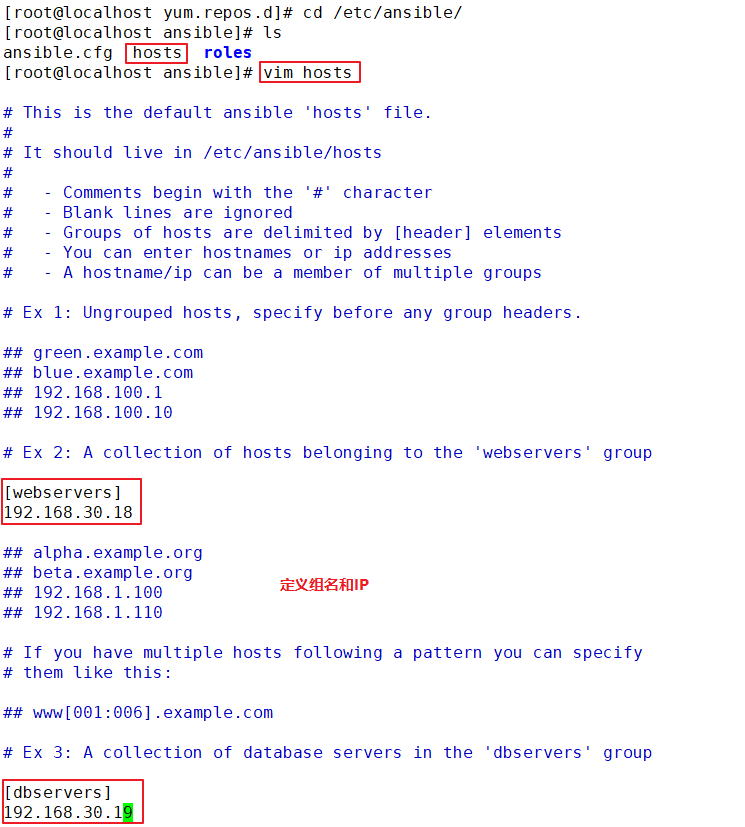
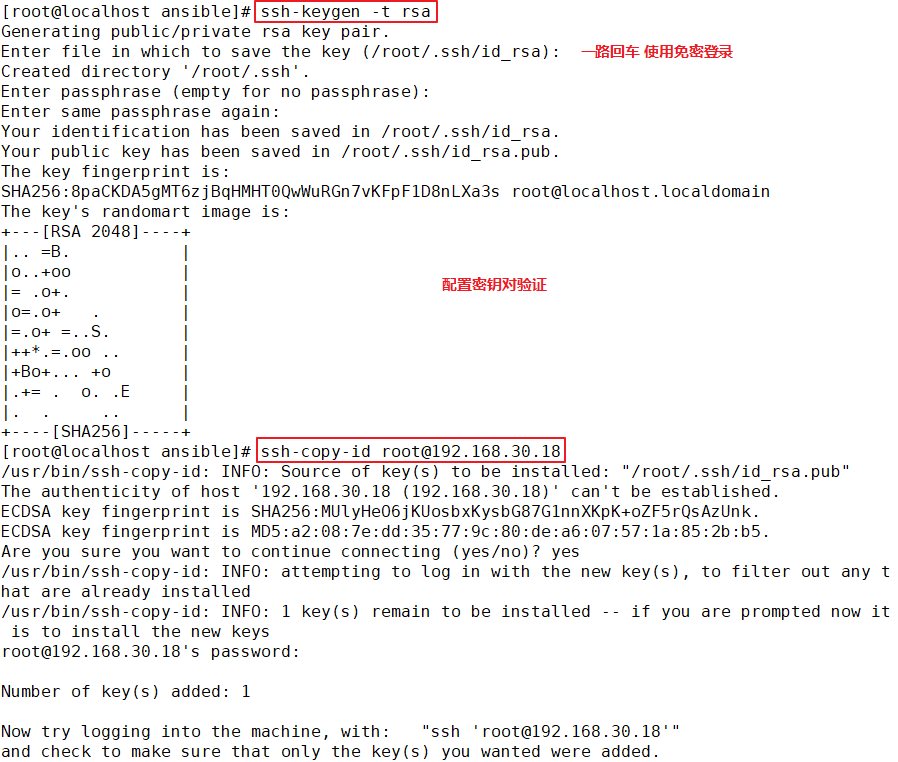
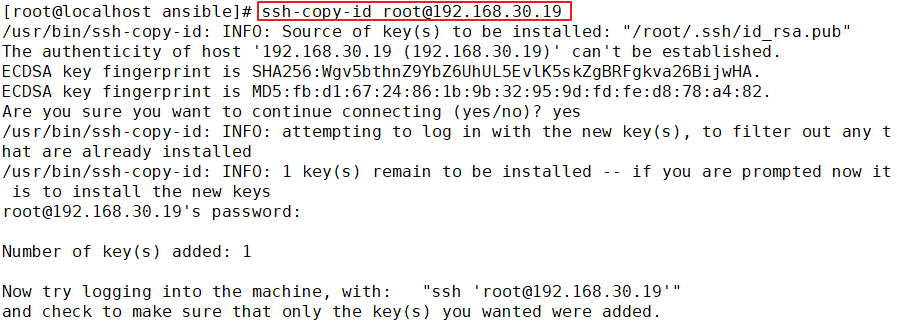
三、ansible 命令行模块
--------- ansible 命令行模块 ---------
命令格式:ansible <组名> -m <模块> -a <参数列表>
ansible-doc -l #列出所有已安装的模块,按q退出
1.command 模块
//在远程主机执行命令,不支持管道,重定向等shell的特性。
ansible-doc -s command #-s 列出指定模块的描述信息和操作动作
ansible 192.168.30.18 -m command -a 'date' #指定 ip 执行 date
ansible webservers -m command -a 'date' #指定组执行 date
ansible dbservers -m command -a 'date'
ansible all -m command -a 'date' #all 代表所有 hosts 主机
ansible all -a 'ls /' #如省略 -m 模块,则默认运行 command 模块
//常用的参数:
chdir:在远程主机上运行命令前提前进入目录
creates:判断指定文件是否存在,如果存在,不执行后面的操作
removes:判断指定文件是否存在,如果存在,执行后面的操作
ansible all -m command -a "chdir=/home ls ./"
2.shell 模块
//在远程主机执行命令,相当于调用远程主机的shell进程,然后在该shell下打开一个子shell运行命令(支持管道符号等功能)
ansible-doc -s shell
ansible dbservers -m shell -a 'echo 123456 | passwd --stdin test"'
ansible dbservers -m shell -a 'echo $(ifconfig ens33 | awk "NR==2 {print $2}") | cut -d " " -f2'
ansible dbservers -m shell -a 'echo $(ifconfig ens33 | awk "NR==2 {print \$2}")'
3.cron 模块
//在远程主机定义任务计划。其中有两种状态(state):present表示添加(可以省略),absent表示移除。
ansible-doc -s cron #按 q 退出
//常用的参数:
minute/hour/day/month/weekday:分/时/日/月/周
job:任务计划要执行的命令
name:任务计划的名称
ansible webservers -m cron -a 'minute="*/1" job="/bin/echo helloworld" name="test crontab"'
ansible webservers -a 'crontab -l'
ansible webservers -m cron -a 'name="test crontab" state=absent' #移除计划任务,假如该计划任务没有取名字,name=None即可
4.user 模块
//用户管理的模块
ansible-doc -s user
//常用的参数:
name:用户名,必选参数
state=present|absent:创建账号或者删除账号,present表示创建,absent表示删除
system=yes|no:是否为系统账号
uid:用户uid
group:用户基本组
shell:默认使用的shell
move_home=yse|no:如果设置的家目录已经存在,是否将已经存在的家目录进行移动
password:用户的密码,建议使用加密后的字符串
comment:用户的注释信息
remove=yes|no:当state=absent时,是否删除用户的家目录
ansible dbservers -m user -a 'name="test01"' #创建用户test01
ansible dbservers -m command -a 'tail /etc/passwd'
ansible dbservers -m user -a 'name="test01" state=absent' #删除用户test01
5.group 模块
//用户组管理的模块
ansible-doc -s group
ansible dbservers -m group -a 'name=mysql gid=306 system=yes' #创建mysql组
ansible dbservers -a 'tail /etc/group'
ansible dbservers -m user -a 'name=test01 uid=306 system=yes group=mysql' #将test01用户添加到mysql组中
ansible dbservers -a 'tail /etc/passwd'
ansible dbservers -a 'id test01'
6.copy 模块
//用于复制指定主机文件到远程主机的
ansible-doc -s copy
//常用的参数:
dest:指出复制文件的目标及位置,使用绝对路径,如果是源目录,指目标也要是目录,如果目标文件已经存在会覆盖原有的内容
src:指出源文件的路径,可以使用相对路径或绝对路径,支持直接指定目录,如果源是目录则目标也要是目录
mode:指出复制时,目标文件的权限
owner:指出复制时,目标文件的属主
group:指出复制时,目标文件的属组
content:指出复制到目标主机上的内容,不能与src一起使用
ansible dbservers -m copy -a 'src=/etc/fstab dest=/opt/fstab.bak owner=root mode=640'
ansible dbservers -a 'ls -l /opt'
ansible dbservers -a 'cat /opt/fstab.bak'
ansible dbservers -m copy -a 'content="helloworld" dest=/opt/hello.txt' #将helloworld写入/opt/hello.txt文件中
ansible dbservers -a 'cat /opt/hello.txt'
7.file 模块
//设置文件属性
ansible-doc -s file
ansible dbservers -m file -a 'owner=test01 group=mysql mode=644 path=/opt/fstab.bak' #修改文件的属主属组权限等
ansible dbservers -m file -a 'path=/opt/fstab.link src=/opt/fstab.bak state=link' #设置/opt/fstab.link为/opt/fstab.bak的链接文件
ansible dbservers -m file -a "path=/opt/abc.txt state=touch" #创建一个文件
ansible dbservers -m file -a "path=/opt/abc.txt state=absent" #删除一个文件
8.hostname 模块
//用于管理远程主机上的主机名
ansible dbservers -m hostname -a "name=mysql01"
9.ping 模块
//检测远程主机的连通性
ansible all -m ping
10.yum 模块
//在远程主机上安装与卸载软件包
ansible-doc -s yum
ansible webservers -m yum -a 'name=httpd' #安装服务
ansible webservers -m yum -a 'name=httpd state=absent' #卸载服务
11.service/systemd 模块
//用于管理远程主机上的管理服务的运行状态
ansible-doc -s service
//常用的参数:
name:被管理的服务名称
state=started|stopped|restarted:动作包含启动关闭或者重启
enabled=yes|no:表示是否设置该服务开机自启
runlevel:如果设定了enabled开机自启去,则要定义在哪些运行目标下自启动
ansible webservers -a 'systemctl status httpd' #查看web服务器httpd运行状态
ansible webservers -m service -a 'enabled=true name=httpd state=started' #启动httpd服务
12.script 模块
//实现远程批量运行本地的 shell 脚本
ansible-doc -s script
vim test.sh
#!/bin/bash
echo "hello ansible from script" > /opt/script.txt
chmod +x test.sh
ansible webservers -m script -a 'test.sh'
ansible webservers -a 'cat /opt/script.txt'
13.setup 模块
//facts 组件是用来收集被管理节点信息的,使用 setup 模块可以获取这些信息
ansible-doc -s setup
ansible webservers -m setup #获取mysql组主机的facts信息
ansible dbservers -m setup -a 'filter=*ipv4' #使用filter可以筛选指定的facts信息
例:
command 模块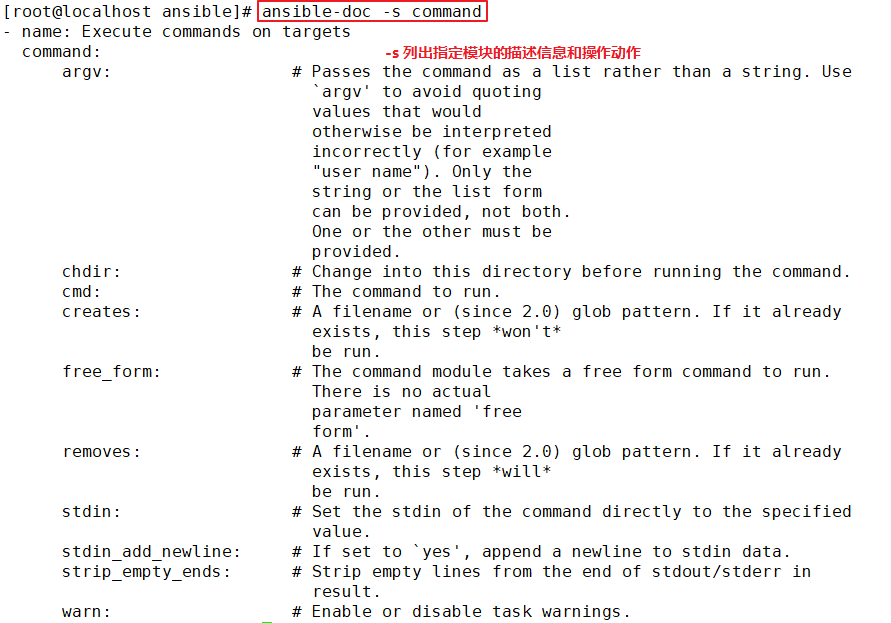
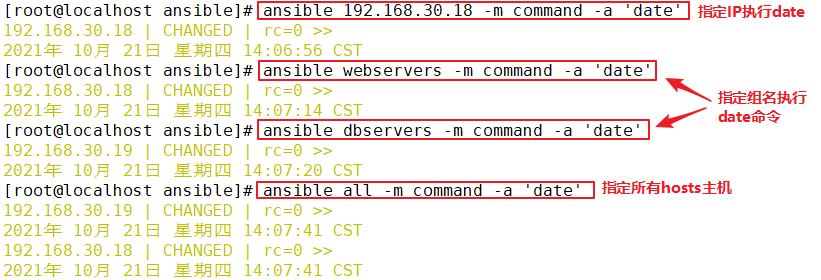
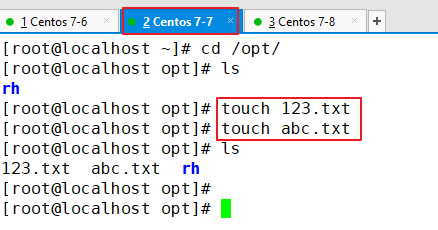

shell 模块


cron 模块
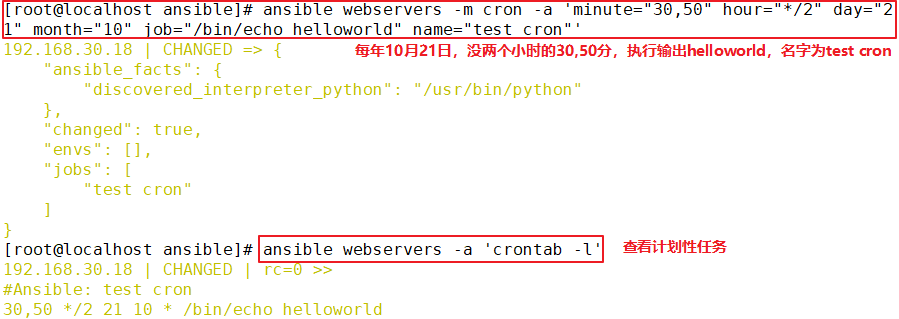

user 模块
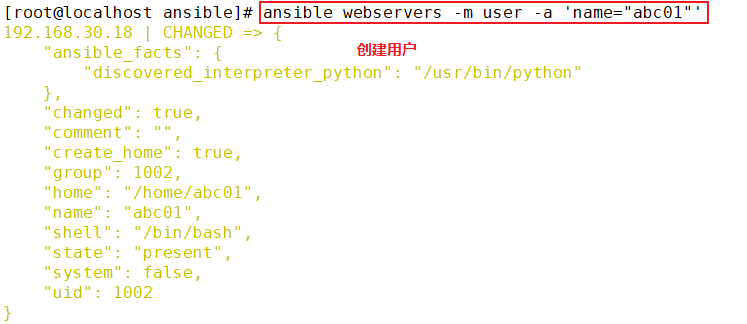

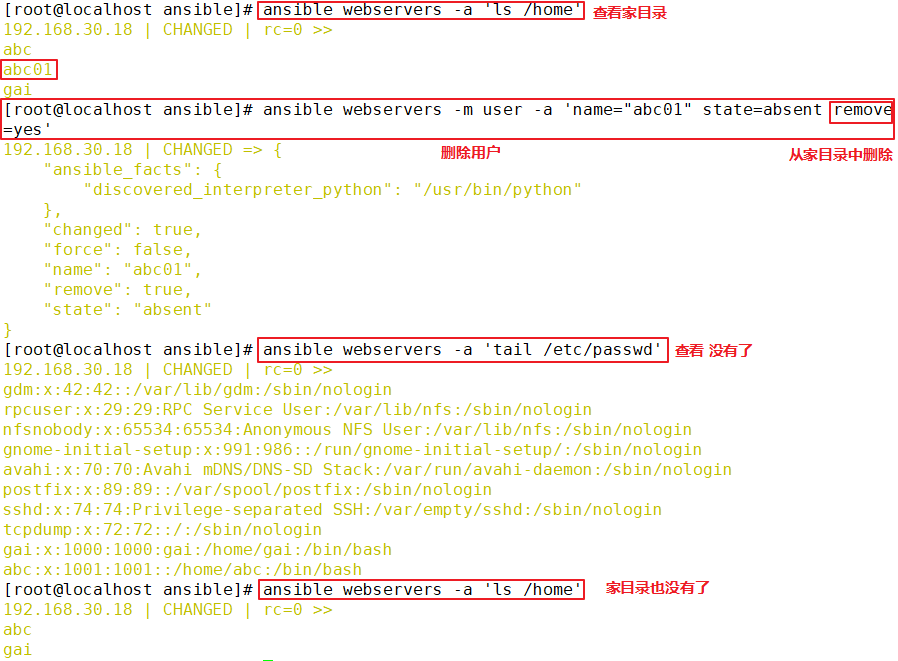
group 模块
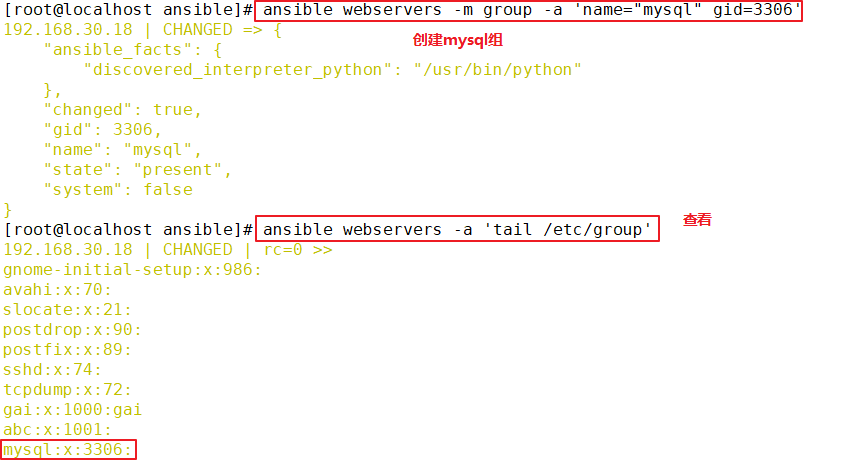
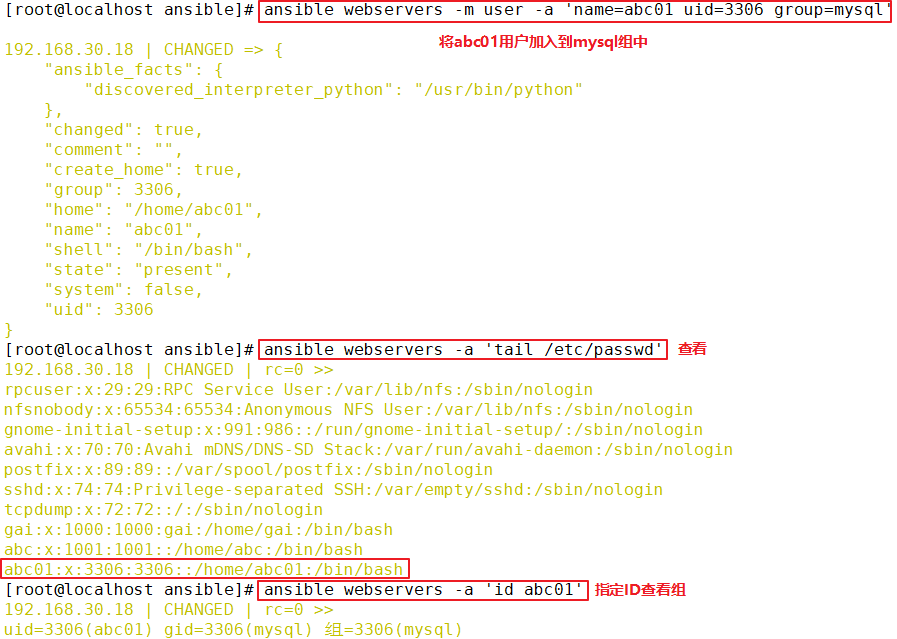
copy 模块
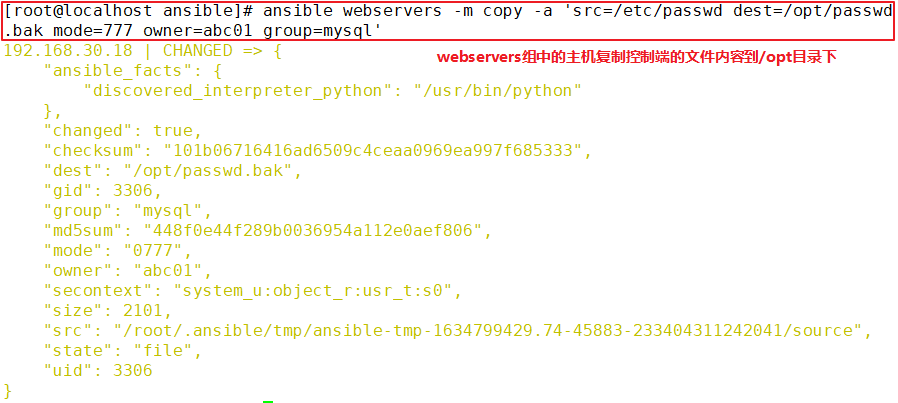
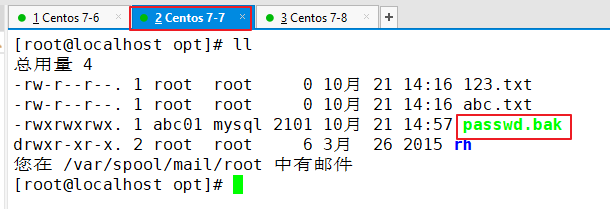
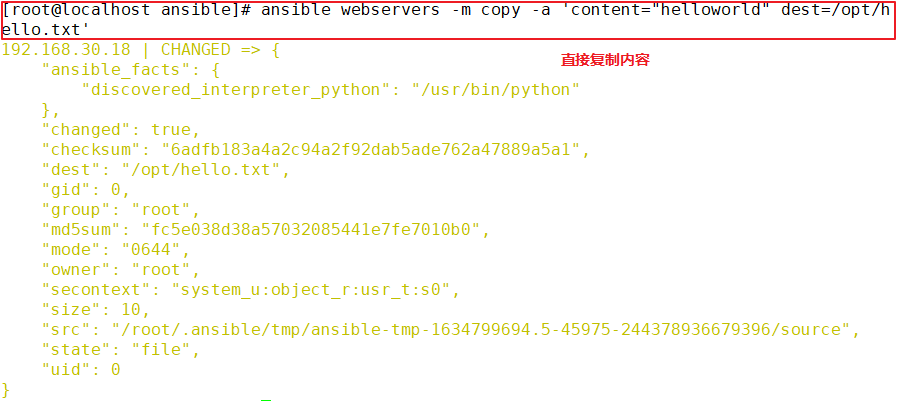

file 模块
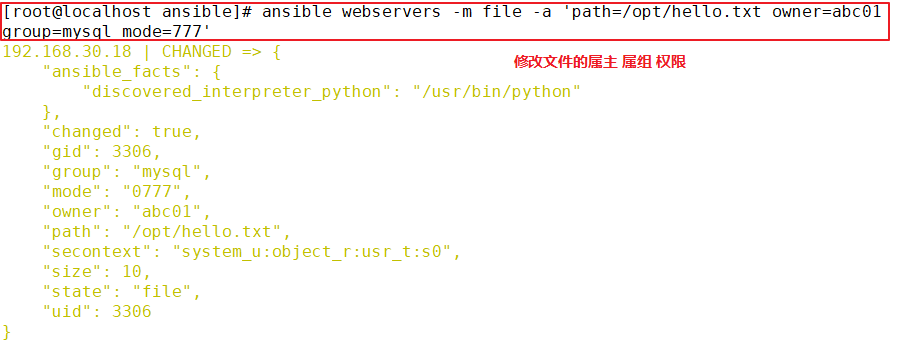

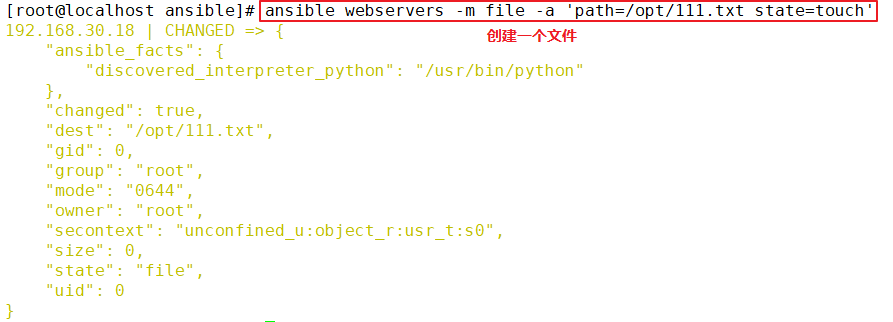



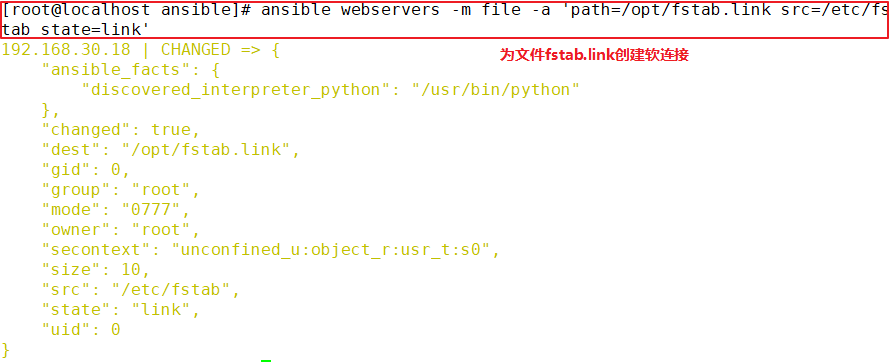

hostname 模块
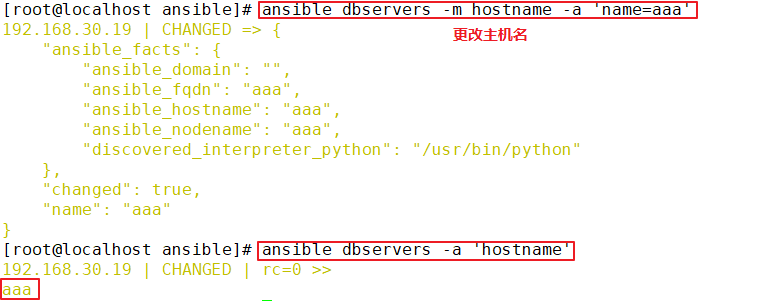

ping 模块
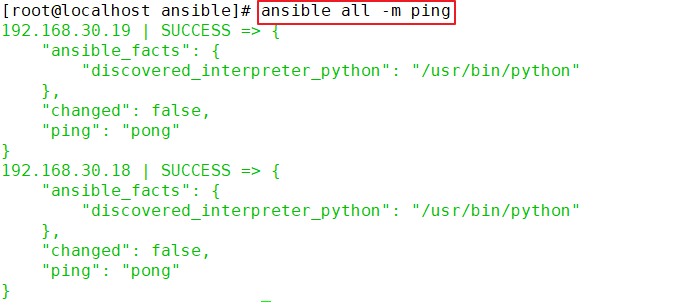
yum 模块



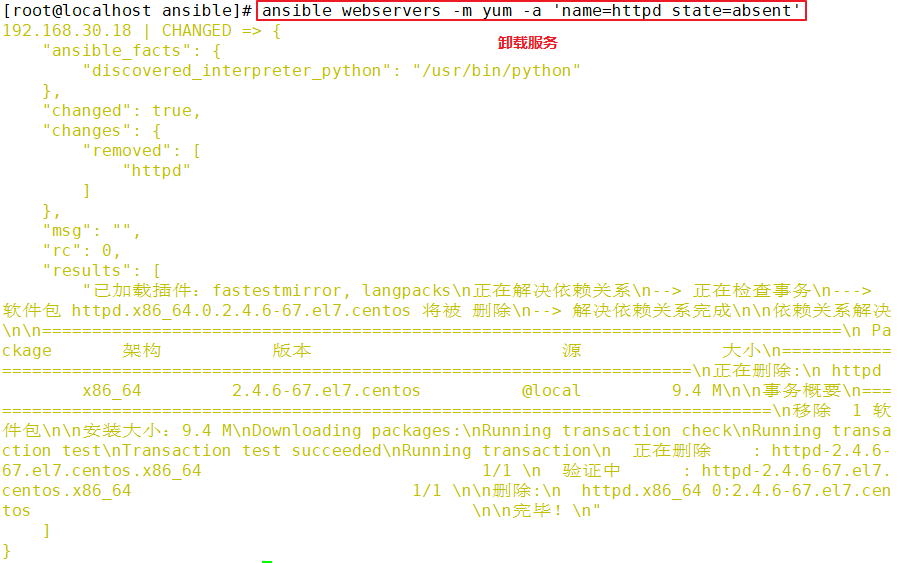

service/systemd 模块
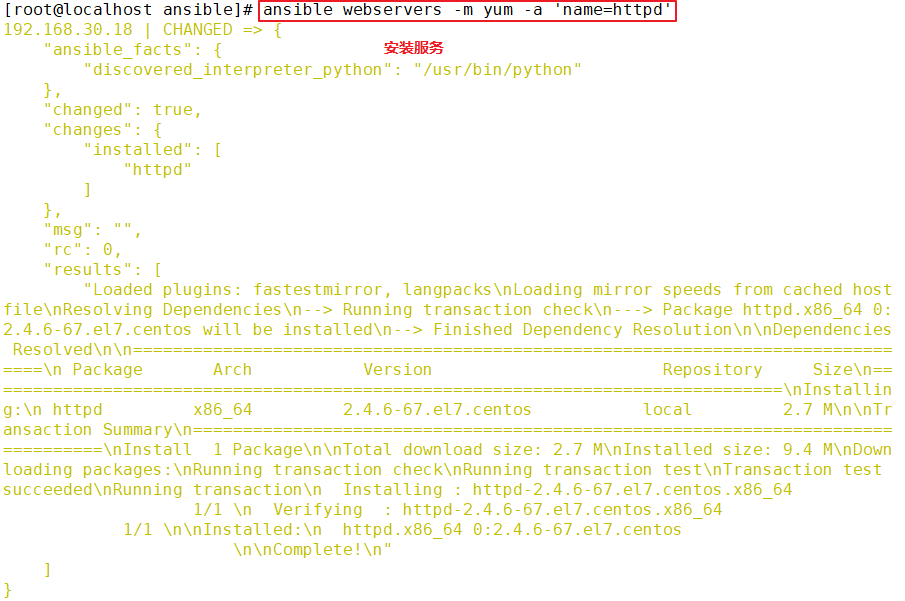

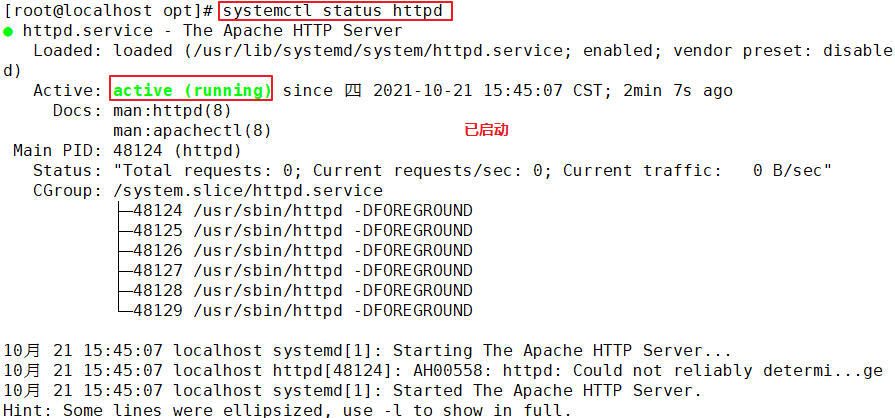



script 模块



setup 模块

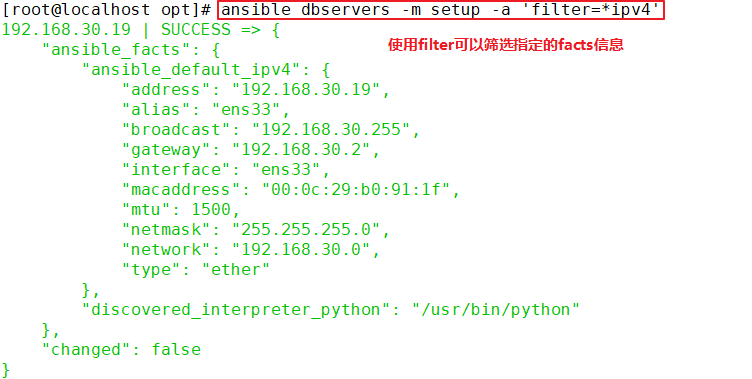
四、inventory 主机清单
--------- inventory 主机清单 --------- //Inventory支持对主机进行分组,每个组内可以定义多个主机,每个主机都可以定义在任何一个或多个主机组内。 //如果是名称类似的主机,可以使用列表的方式标识各个主机。 vim /etc/ansible/hosts [webservers] 192.168.30.18:2222 #冒号后定义远程连接端口,默认是 ssh 的 22 端口 192.168.30.1[2:5] [dbservers] db-[a:f].example.org #支持匹配 a~f //inventory 中的变量 Inventory变量名 含义 ansible_host ansible连接节点时的IP地址 ansible_port 连接对方的端口号,ssh连接时默认为22 ansible_user 连接对方主机时使用的主机名。不指定时,将使用执行ansible或ansible-playbook命令的用户 ansible_password 连接时的用户的ssh密码,仅在未使用密钥对验证的情况下有效 ansible_ssh_private_key_file 指定密钥认证ssh连接时的私钥文件 ansible_ssh_common_args 提供给ssh、sftp、scp命令的额外参数 ansible_become 允许进行权限提升 ansible_become_method 指定提升权限的方式,例如可使用sudo/su/runas等方式 ansible_become_user 提升为哪个用户的权限,默认提升为root ansible_become_password 提升为指定用户权限时的密码 (1)主机变量 [webservers] 192.168.30.18 ansible_port=22 ansible_user=root ansible_password=abc1234 (2)组变量 [webservers:vars] #表示为 webservers 组内所有主机定义变量 ansible_user=root ansible_password=abc1234 [all:vars] #表示为所有组内的所有主机定义变量 ansible_port=22 (3)组嵌套 [nginx] 192.168.30.20 192.168.30.21 192.168.30.22 [apache] 192.168.30.3[0:3] [webs:children] #表示为 webs 主机组中包含了 nginx 组和 apache 组内的所有主机 nginx apache



